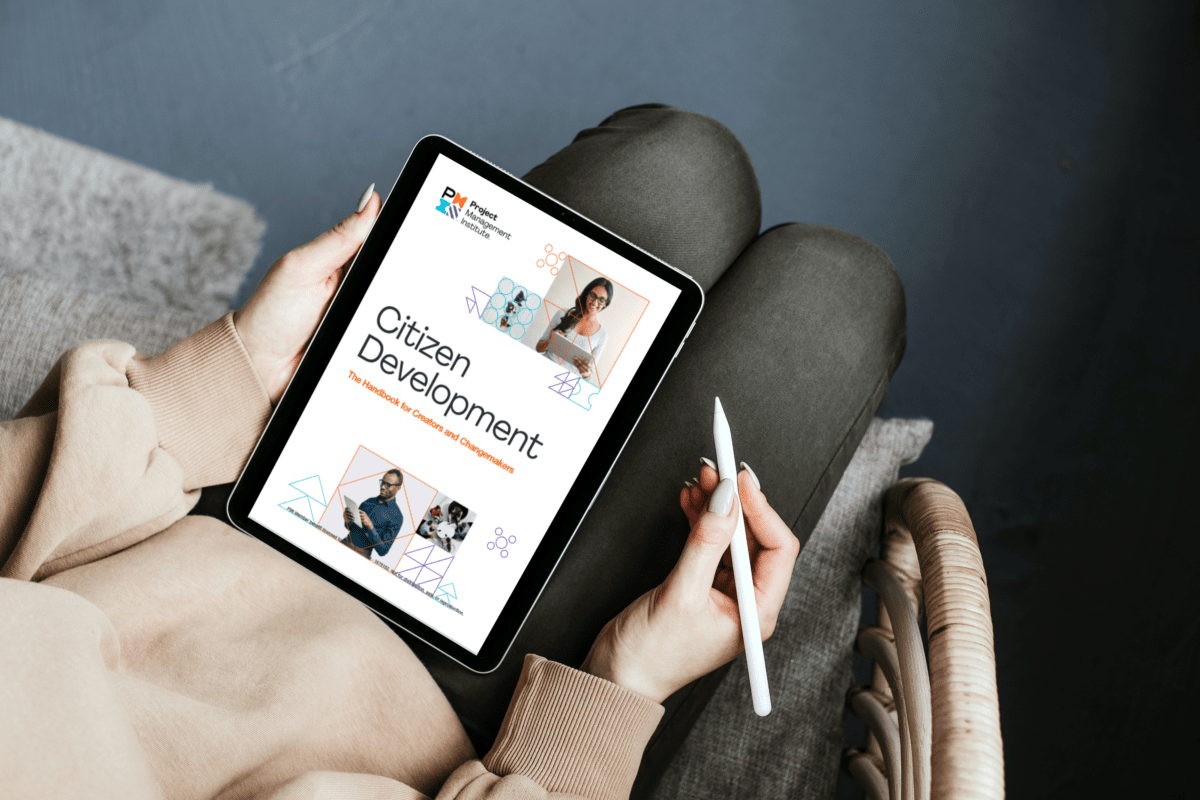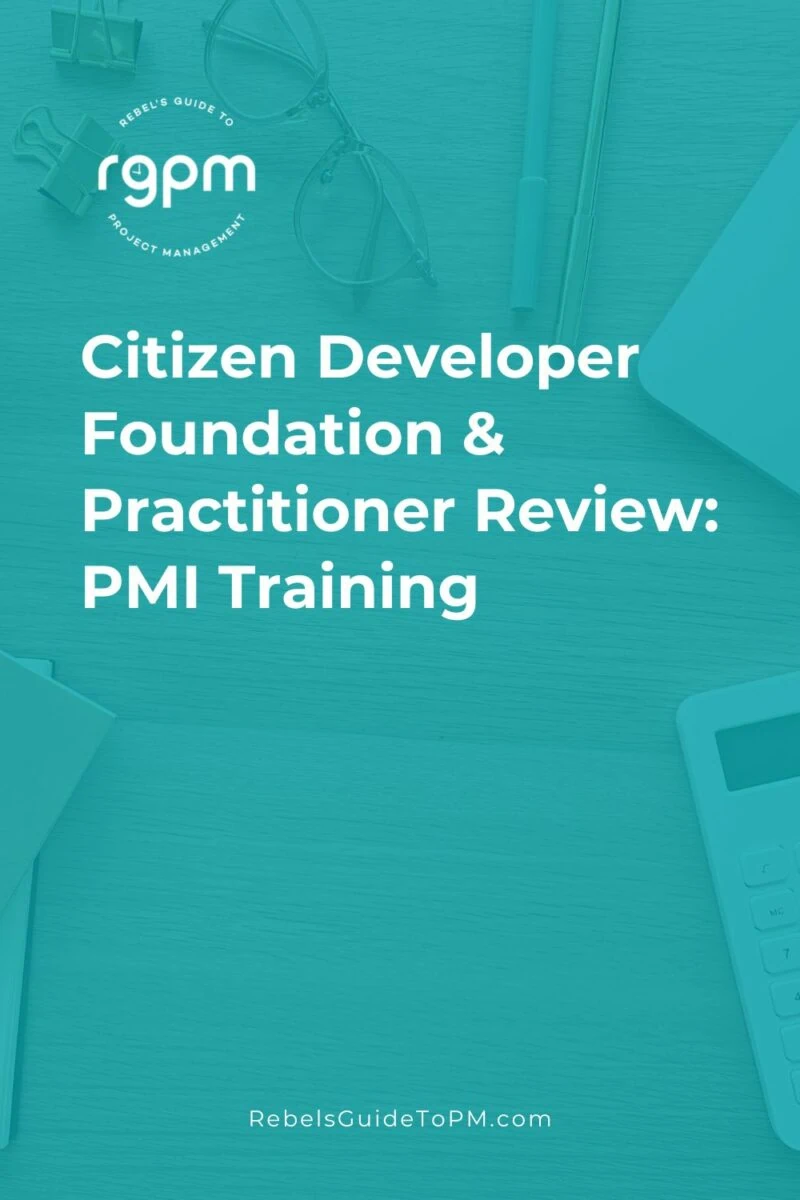Citizen Developer Foundation & Practitioner Review: PMI Training
This blog is reader-supported. When you purchase something through an affiliate link on this site, I may earn some coffee money. Thanks! Learn more.
Read our review guidelines.
Could you be a citizen developer? I use low-code and no-code tools for various different automations and data processing at work, and while I’m no expert, the low-code revolution is going to make it easier for us all to do a whole lot of stuff without input from IT.
The more robotic process automation tools out there, the easier it is to use drag-and-drop platforms and APIs to create our own multi-system interfaces (and more).
Tech disruption is huge in our industry, so why not get ahead and show employers that you are ready to take the lead and can lead low-code app development projects? But is this just a fad and another pointless certification?
I’ve dived into the world of citizen development to help you decide if you should take this PMI Foundation and Practitioner course.
Citizen development is someone who uses low code tools to create business applications that could be used by others. It is done outside of the IT development environment but with the support of IT.
In a situation where the IT team is busy working on large digital disruption or strategic initiatives, they probably don’t have a lot of time to focus on business processes and how those could be improved.
Skilled developers are in demand. But development costs are coming down, and there are many low-code/no-code platforms available now. With straightforward application logic, a hands-on approach to software development, and an easy-to-understand user interface, anyone can build simple tools for their business unit.
Business users, like project managers and teams, are using this approach to take some of the workload off application developers.

Comparison of the two levels
You can take either the Foundation or Practitioner Citizen Developer course. The main differences are shown in the table below.
| Foundation | Practitioner | |
|---|---|---|
| Education requirements | None | None |
| Experience requirements | None | 1-5 years project management experience is what PMI suggests |
| Professional development requirements | None. Once you’ve passed, you’ve got the credential for life | None. Once you’ve passed, you’ve got the credential for life |
| Course length | 1.5 hours | 5 hours + exam |
| Exam | None | 60-minute multiple choice exam with 40 questions |
| Value | Certification of completion and 2 PDUs | Micro-credential, digital badge, 6 PDUs |
| Price | $79 | $249 |
| Learn more | Foundation | Practitioner |
The biggest difference is that there is an exam with Practitioner, and there isn’t with Foundation.
In addition, the Project Management Institute recommends that you have some PM and/or citizen development experience for Practitioner. That’s because the course content is really about how to manage a low-code app project. If you’ve not managed the process of ideation, ideas assessment, business analysis, design, development, and deployment before then, you might find the course a stretch.
Let’s look next at the content of each of the courses.
The Citizen Developer Foundation (CD-F) course
The course seems to be an e-learning version of parts of the Handbook, which PMI members can get for free anyway.
It covers:
- What citizen development is all about and why you should care about it: a general overview of how it fits into business
- The citizen development canvas overview: a useful tool to help frame low code projects covering the doing and the management along with a maturity model.
- Ideation 2.0: Coming up with ideas and refining them on an iterative basis using tools like a product vision board, user stories, or a hackathon.
Who is it for?
It’s a very light overview of what this tech trend is all about. Honestly, unless you learn better through e-learning and not reading, then a better approach would be to get the handbook and read through the 255 pages, which covers everything you need to know, including these topics.
It will take you longer, but you’ll get a real understanding.
I think this course is only for people new to the workforce who are early in their career journey and not PMI members. I can’t think of anyone else who would get much from this – maybe senior leaders in IT so they don’t worry about all the potential shadow IT that’s being created by people building low-code apps?
The Citizen Developer Practitioner (CD-P) course
The goal of this course is to give you the tools and skills to effectively create applications using (unspecified) low-code tools. It’s not a course about how to use a particular tech suite. Instead, it covers the process of how to go from idea to app and what’s involved in leading those kinds of ‘simple’ low/no code application developments.
The Practitioner level course is made up of 8 modules. I would consider only 6 of them to be content-led modules. The other 2 are the intro and the conclusion – so scene setting and review prior to the exam.
The main modules are:
- Hyper-agile software delivery lifecycle: Understanding SDLC methods and then how they are adapted to deliver projects at ‘hyper
agile ’ pace (is that even a thing? They mean short projects). - Ideation: Tools and techniques for iterating through ideas and turning them into solutions.
- Suitability assessment: Now we have an idea, is low/no code development to create an app the right solution?
- Business analysis and design: The theory behind an approach to design thinking and how your app fits into the organization overall.
- Risks: Project and enterprise risks and how to manage those.
- Application design, development, and deployment: How to get from having an idea through to designing and building the app solution.
Who is it for?
The course is designed for anyone who is working in an environment where there is a demand for quick-turnaround solutions AND has the low code tech suite that would enable solutions to be built fast.
It’s best for people who have some project experience, although it doesn’t have to be in an
Which course is right for you?
Frankly, the Foundation course is pitched as such an introductory level that I would not recommend it. Foundation is only for you if you can’t read enough online to know if you’d like to learn more about citizen development and the no/low code world. And you don’t have access to the benefits of PMI membership. Then it might be worth paying the lower course fee and checking it out before committing to the Practitioner exam.
I would go straight to Practitioner. I wish there was a discount off Practitioner if you have already done Foundation for people who take that route, but as there isn’t, just go straight here.
If you work in a field that is being disrupted by tech and you feel there is a lot of scope for new business applications that could be relatively simple and don’t need a professional developer, then it might be worth doing this course for the certification and digital badge.
But my summary is that if you are a project leader with some experience, a decent amount of tech literacy, and you are prepared to leap into citizen development tools to experiment, then you could go quite far with just the handbook.
Pin for later reading

